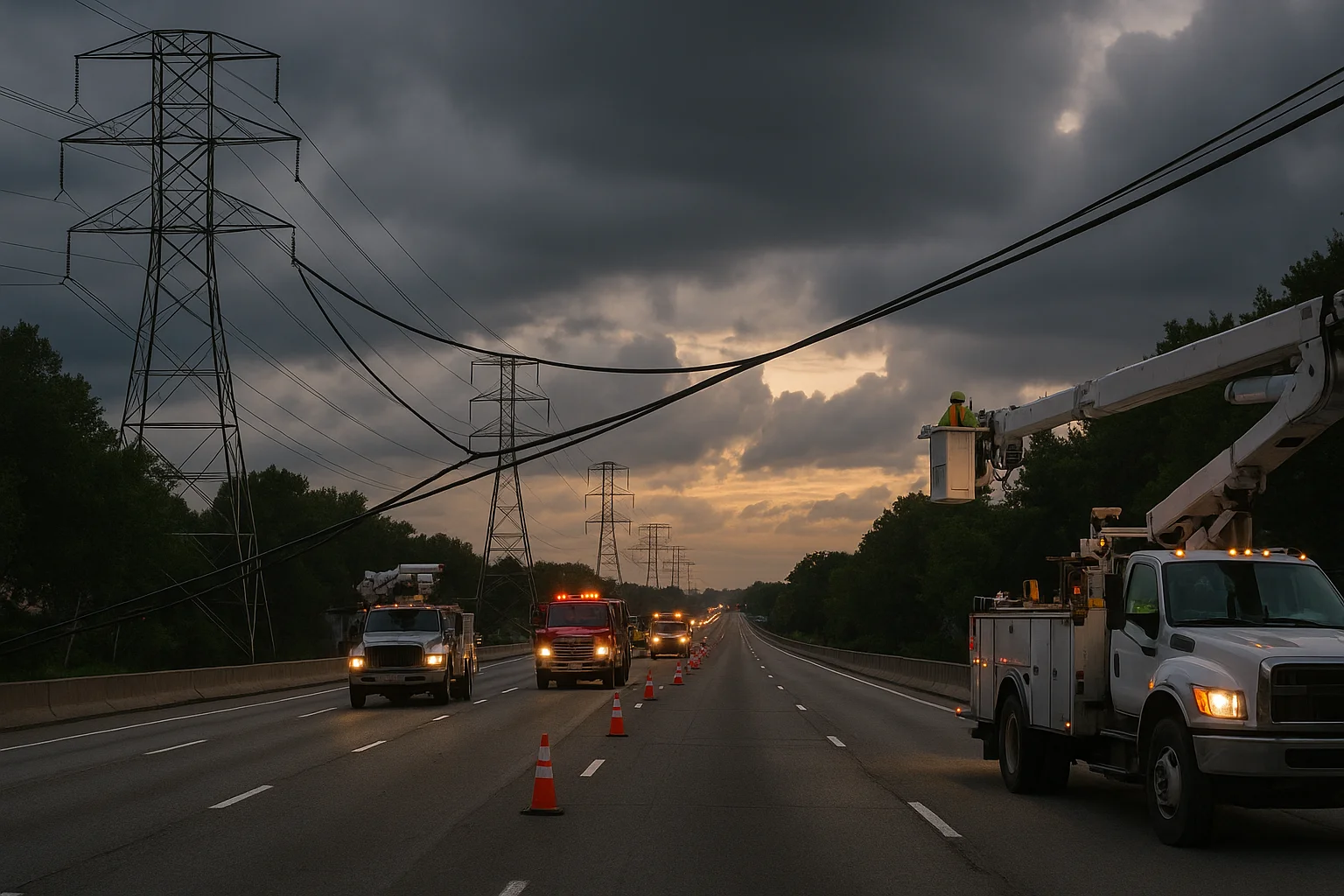When drivers woke up to the news of the i-75 power line shutdown today, confusion and concern spread quickly across Ohio and surrounding states. Interstate 75 is one of the nation’s most vital transportation arteries, linking the Great Lakes to the Gulf of Mexico. Any closure along this route—especially one caused by downed power lines—doesn’t just slow traffic; it disrupts commerce, safety, and community life.
Over the past weekend, severe thunderstorms tore through Northeast Ohio, leaving destruction in their wake. Along with fallen trees and flooded roadways, a downed power line incident on I-75 brought traffic to a standstill. For many travelers, the first question was simple: Is Interstate 75 shut down completely, and if so, for how long? Others wanted to know if it was connected to the recent I-75/85 shutdown events in other regions.
This article takes you inside the details—what led to the closure, how it impacts communities, and what drivers and residents should do during situations like these.
The Chain of Events Behind the I-75 Power Line Shutdown
The i 75 power line shutdown was not a minor inconvenience—it was the direct result of extreme weather. Late Sunday night, Northeast Ohio experienced severe storms causing power outages across multiple counties. Winds gusted up to 70 mph, strong enough to knock utility poles over like matchsticks. In one critical stretch near Dayton, power lines collapsed directly onto the interstate.
Officials from the Ohio Department of Transportation (ODOT) immediately shut down I-75 in both directions to ensure driver safety. Utility crews, already stretched thin by widespread outages, were dispatched to the scene to remove the debris and make emergency repairs.
A situation like this is dangerous for more reasons than traffic delay. Live electrical wires on a roadway can carry deadly voltage. Even after storms pass, wet pavement and damaged infrastructure can keep the risk level high. That’s why the decision to close the highway wasn’t just precautionary—it was essential.
Why Power Line Incidents Require Immediate Road Closures
For those unfamiliar with utility safety protocols, it might seem excessive to close miles of interstate over a few fallen cables. In reality, a downed power line is one of the most unpredictable and dangerous storm aftereffects.
Here’s why:
- High Voltage Hazard – Power lines often carry tens of thousands of volts, enough to cause fatal injuries instantly.
- Invisible Danger – Electricity can travel through water, metal, and even asphalt, making it hard to see where danger ends.
- Secondary Accidents – Drivers who swerve to avoid debris may cause collisions, especially in low visibility.
If you ever encounter a downed line, the safest action is to stay far away and immediately call emergency services. In Ohio, you can contact 911 first, then follow up with your utility company. For those wondering downed power line who to call, most utility providers like FirstEnergy or AES Ohio have dedicated outage hotlines.
The Wider Impact of Severe Thunderstorms on Ohio’s Power Grid
The I-75 power line shutdown today is just one symptom of a larger issue—Ohio’s vulnerability to severe weather events. This summer alone, severe thunderstorms have caused power outages in Ohio multiple times, affecting hundreds of thousands of homes.
The state’s power grid is a complex web of high-voltage lines, transformers, and substations. A single damaged section can cause a ripple effect, cutting power to entire neighborhoods and forcing road closures.
During the most recent storm, the following occurred:
- Over 150,000 residents lost electricity.
- Traffic lights went dark, increasing road hazards.
- Critical facilities like hospitals had to switch to backup generators.
How the I-75 Shutdown Compares to Past Interstate Closures
Some travelers confused this incident with the I-75/85 shutdown that occurred in Atlanta last year due to a fire under an overpass. While the cause was different, the disruption level was similar—long detours, traffic congestion, and extended delays.
In Ohio, I-75 shut down this weekend for several hours while crews worked. Southbound lanes reopened first, followed by the northbound side once inspections confirmed it was safe.
In addition, there was concern about whether the closure extended into I-75 Ohio segments further north, but ODOT confirmed that only the affected section was blocked.
Safety Protocols: What Drivers Should Do During a Power Line Shutdown
When an event like the i 75 power line shutdown occurs, drivers can reduce risks by following these steps:
1. Pay Attention to Official Alerts
Sign up for text or email updates from ODOT or your local Department of Transportation. This ensures you know about closures before you’re already stuck in traffic.
2. Keep a Detour Plan Ready
Apps like Google Maps and Waze update in real time, but during major shutdowns, even side streets can get clogged. Familiarize yourself with alternate highways in advance.
3. Recognize Electrical Hazards
If you see a downed line, never try to move it yourself. Stay at least 30 feet away and report it immediately.
4. Prepare for Extended Delays
Keep water, snacks, and a portable charger in your car. In incidents like the i-75 power line shutdown today, delays can stretch for hours.
The Role of Utility Companies in Restoring Service
When storms hit, utility companies prioritize repair work based on a “critical services first” model. Hospitals, emergency services, and high-density neighborhoods get top priority. Road closures like the I-75 Ohio incident are high on the list because they affect both safety and commerce.
Crews typically work in dangerous conditions—sometimes with ongoing rain and wind—making the repair process slow. Even once power lines are removed from the road, full restoration can take days if nearby infrastructure is damaged.
Case Study: The August 2024 I-75 Shutdown in Toledo
In August 2024, a similar i 75 power line shutdown happened in Toledo after a transformer explosion. The closure lasted nearly 12 hours, causing major freight delays. That incident taught transportation agencies valuable lessons:
- Faster deployment of repair crews.
- Better coordination between ODOT and utility companies.
- Improved public communication via social media.
The current shutdown shows those lessons are being applied—traffic was rerouted faster, and live updates kept the public informed.
Economic Impact of the I-75 Power Line Shutdown
While most news coverage focuses on traffic, the economic cost is equally significant. Interstate 75 is a major freight corridor. When it’s blocked:
- Trucking companies face delivery delays.
- Perishable goods risk spoilage.
- Manufacturers miss just-in-time supply deadlines.
According to the American Transportation Research Institute, every hour of delay on a major freight route can cost businesses thousands of dollars. The i-75 power line shutdown today likely cost Ohio’s economy millions in lost productivity.
Long-Term Solutions to Prevent Future Shutdowns
Experts suggest several strategies to minimize the risk of future shutdowns:
- Burying Power Lines – This can protect them from wind damage, though it’s expensive.
- Stronger Utility Poles – Modern composite materials can withstand higher wind speeds.
- Improved Vegetation Management – Trimming trees near lines can prevent storm damage.
Some cities in Ohio are already experimenting with these methods, but statewide implementation will take years.
Pro Tips for Travelers During Interstate Power Line Incidents
- Always check Is Interstate 75 shut down before planning your trip, especially during storm season.
- If you must travel during severe weather, carry an emergency kit with flashlights, blankets, and food.
- Bookmark official ODOT traffic cameras to see live conditions.
Common Mistakes People Make During a Power Line Shutdown
- Driving Around Barricades – This is not only illegal but can be deadly.
- Assuming the Line is Dead – Even if it’s not sparking, a line can still carry lethal current.
- Ignoring Alternate Routes – Hoping the road will reopen soon can cost you hours.
FAQs About the I-75 Power Line Shutdown
Q1: What caused the latest i-75 power line shutdown?
Severe thunderstorms in Northeast Ohio knocked utility poles onto the highway, forcing a temporary closure for safety.
Q2: How long was I-75 shut down this weekend?
The affected section was closed for several hours, with repairs and inspections extending into the next day.
Q3: Is Interstate 75 shut down often for weather events?
Not frequently, but Ohio’s storm season can cause occasional closures due to flooding or downed lines.
Q4: Who should I call if I see a downed power line?
Dial 911 first, then notify your local utility company. Do not attempt to handle it yourself.
Q5: How can I stay updated on I-75 shutdowns?
Follow ODOT alerts, local news, and official traffic apps for real-time updates.
Final Thoughts
The i 75 power line shutdown serves as a reminder of how interconnected our transportation and power systems are. A single storm can ripple through every part of daily life—slowing commutes, disrupting businesses, and even endangering lives. By staying informed, respecting closures, and preparing for emergencies, we can navigate these challenges more safely.
The next time you hear about an I-75 Ohio closure or wonder Is Interstate 75 shut down, remember that behind those headlines are teams of first responders, utility crews, and transportation officials working tirelessly to keep everyone safe.


